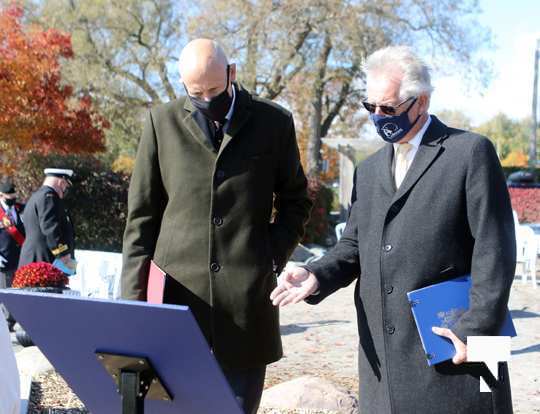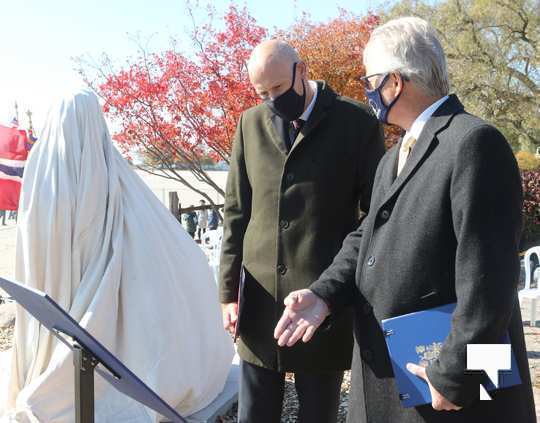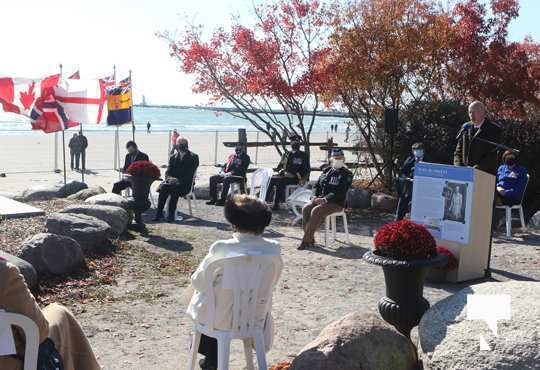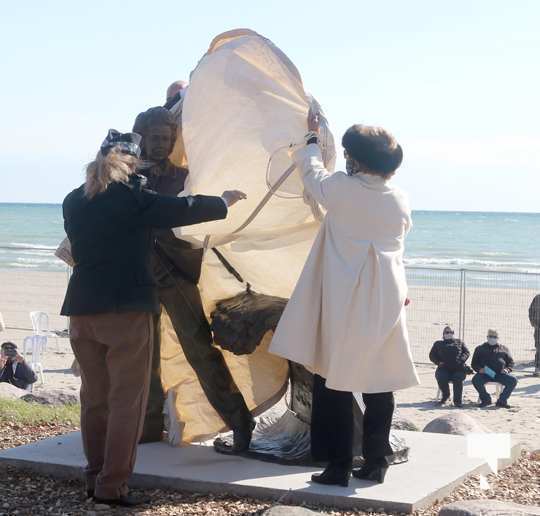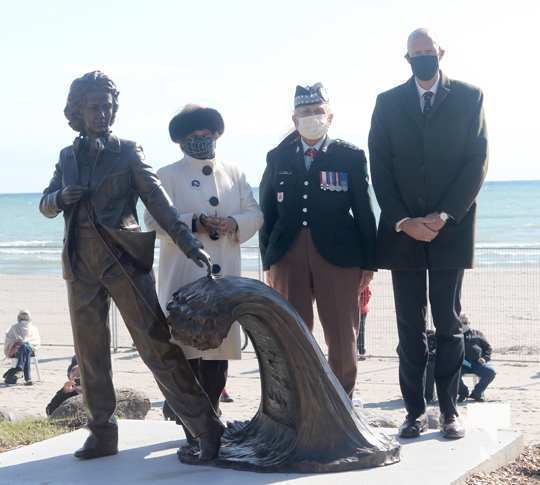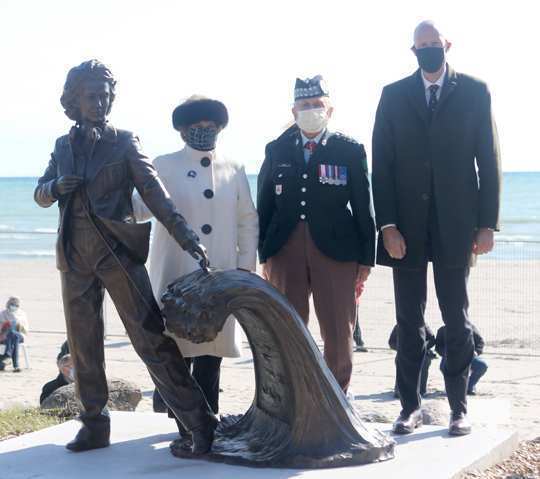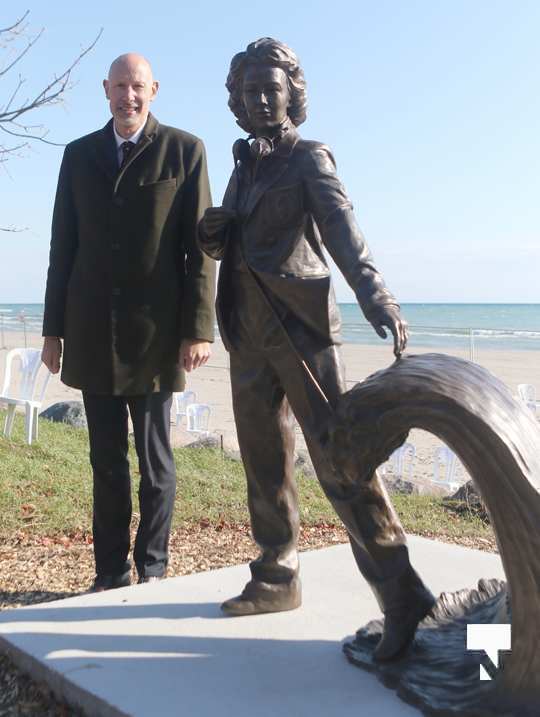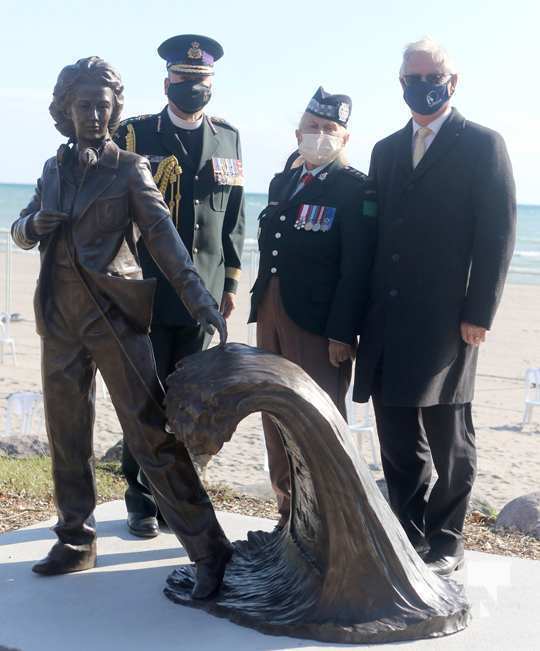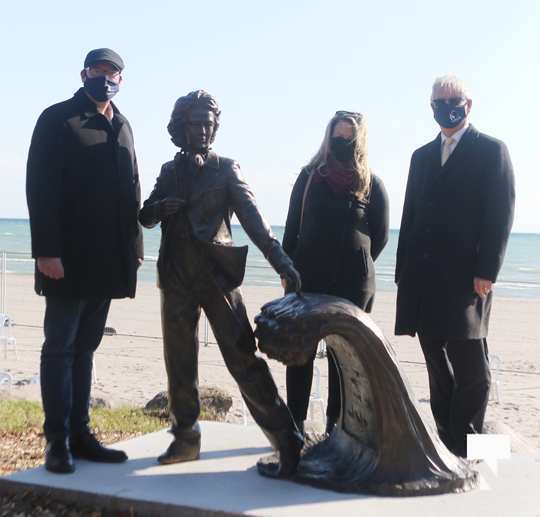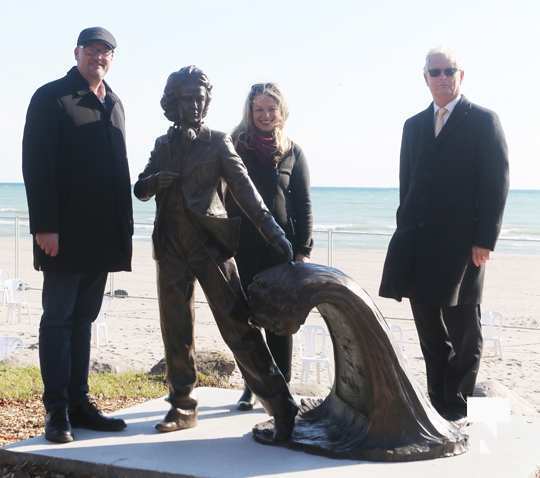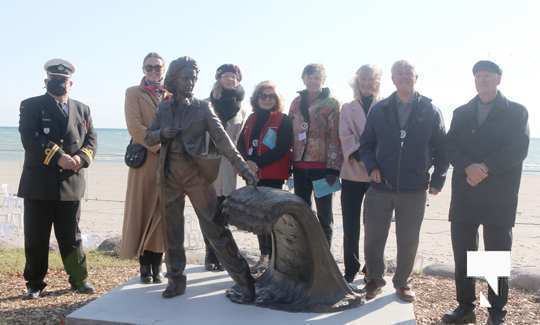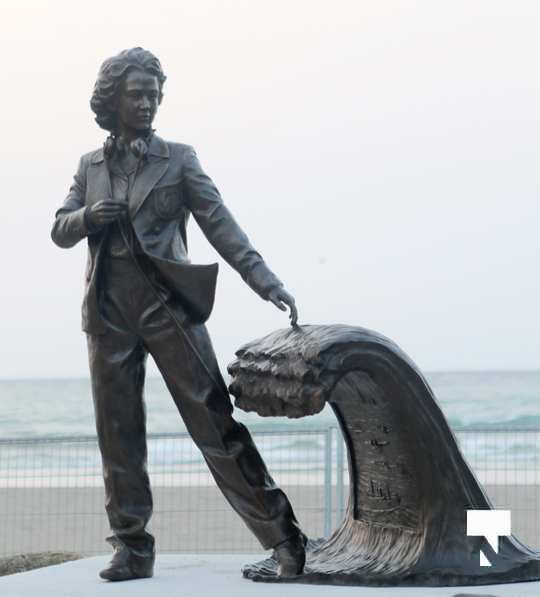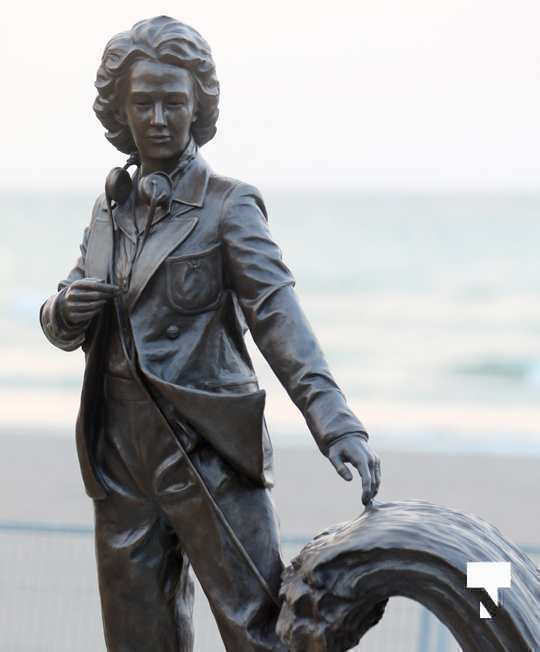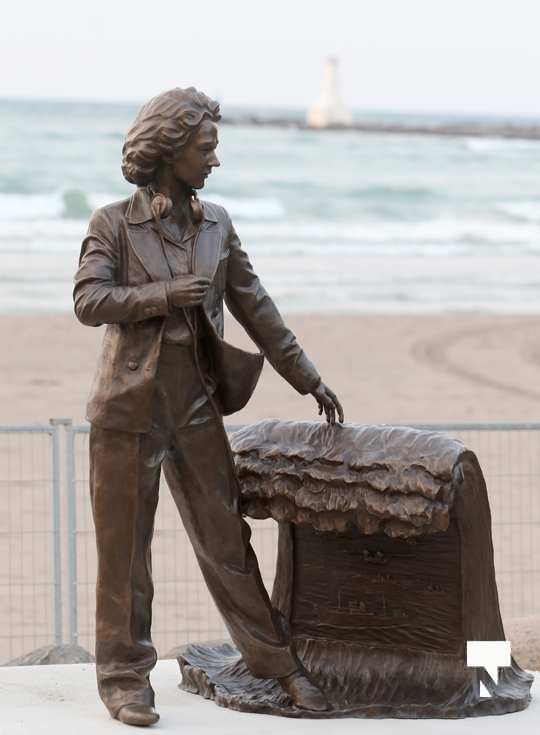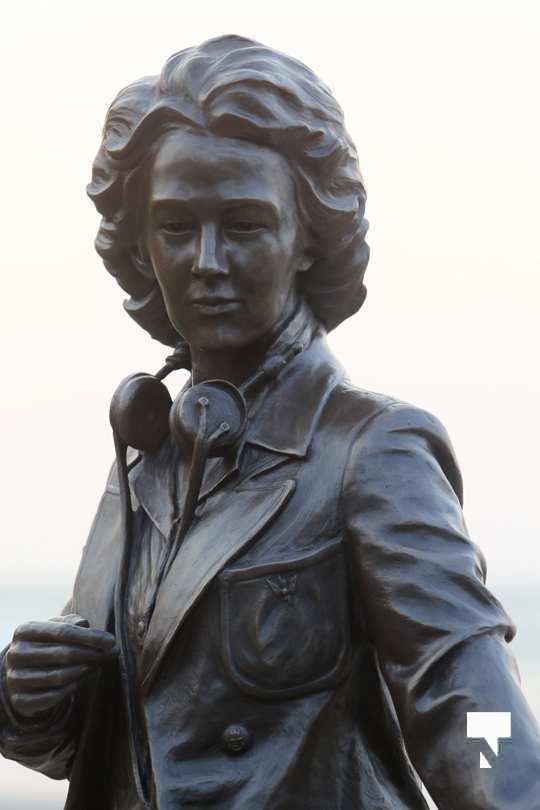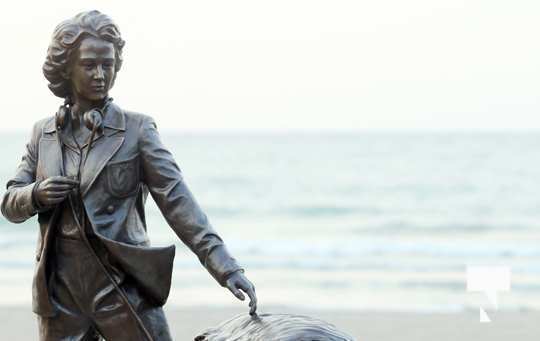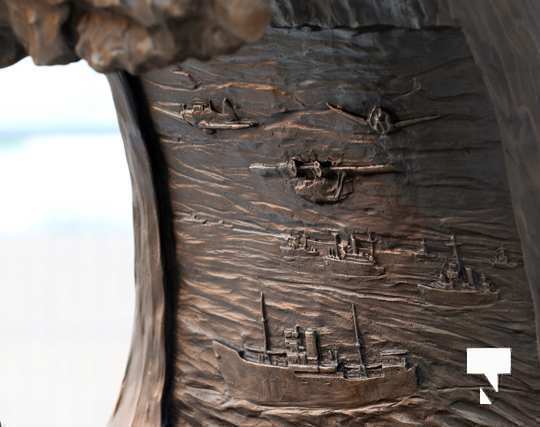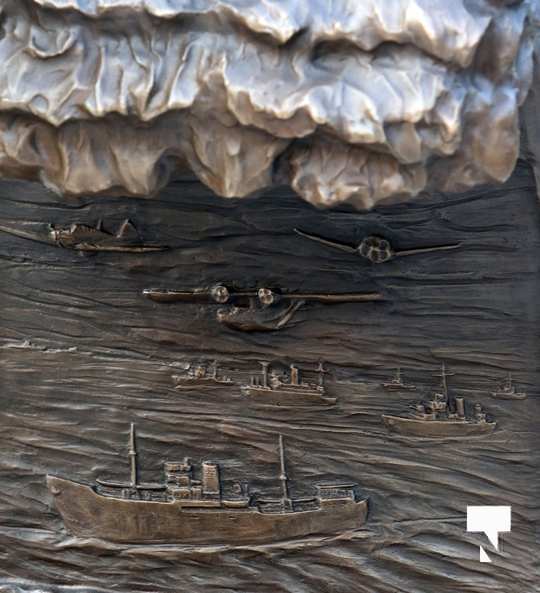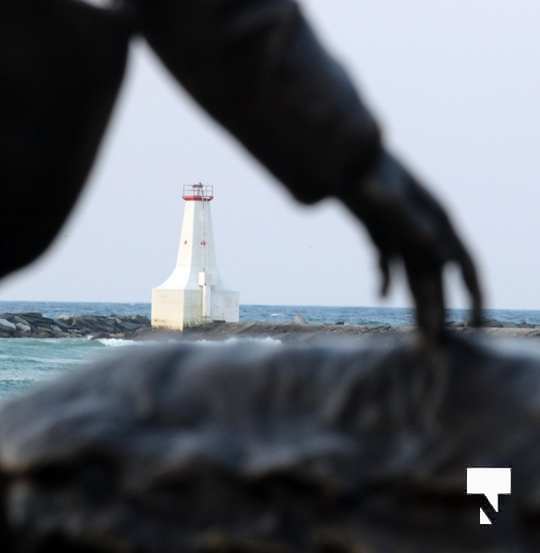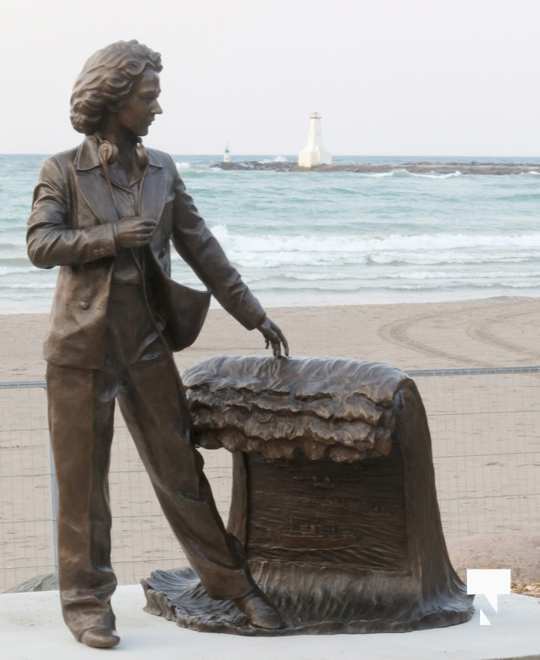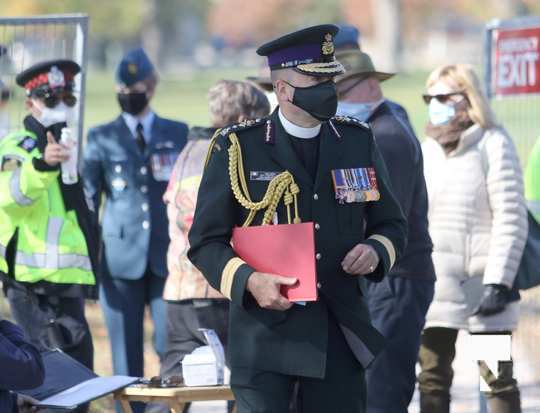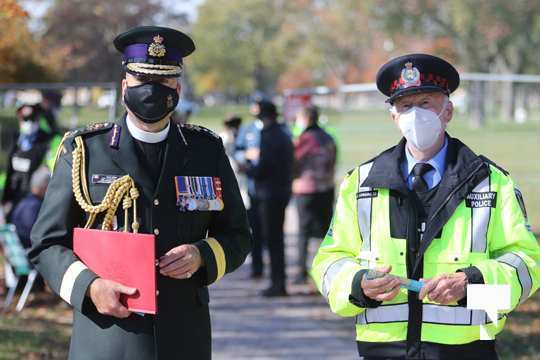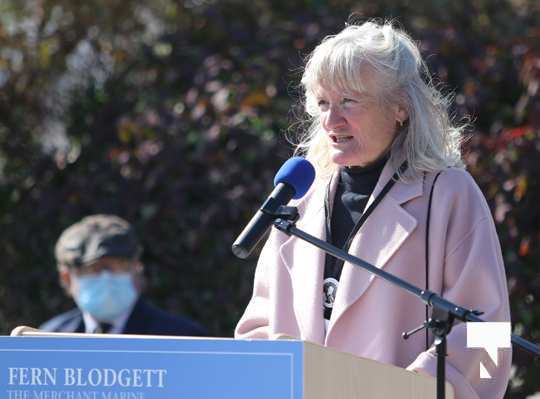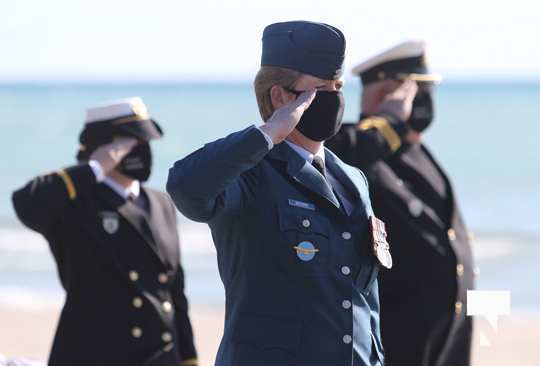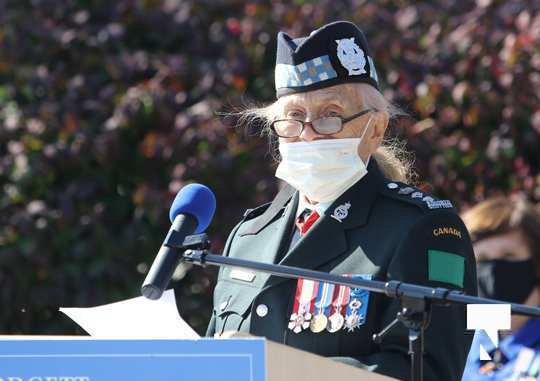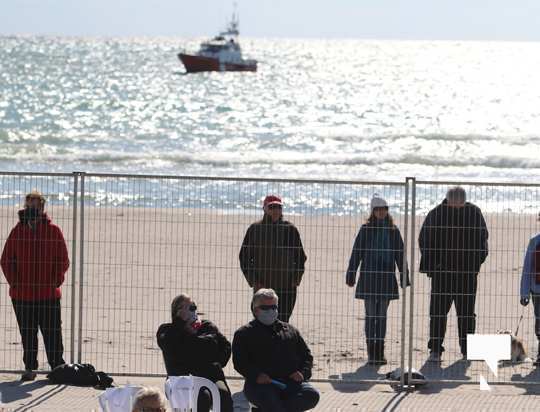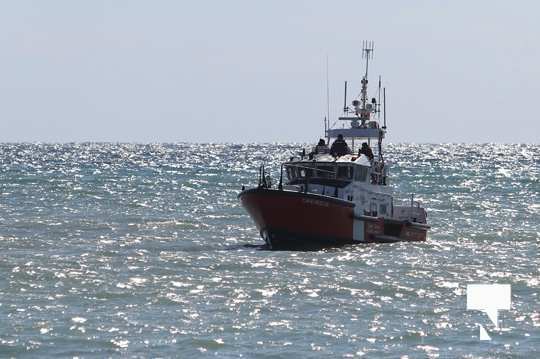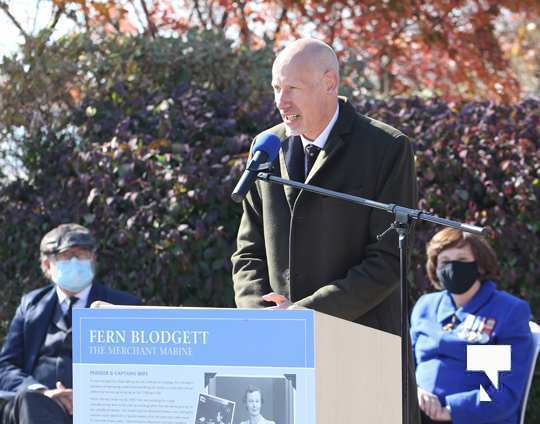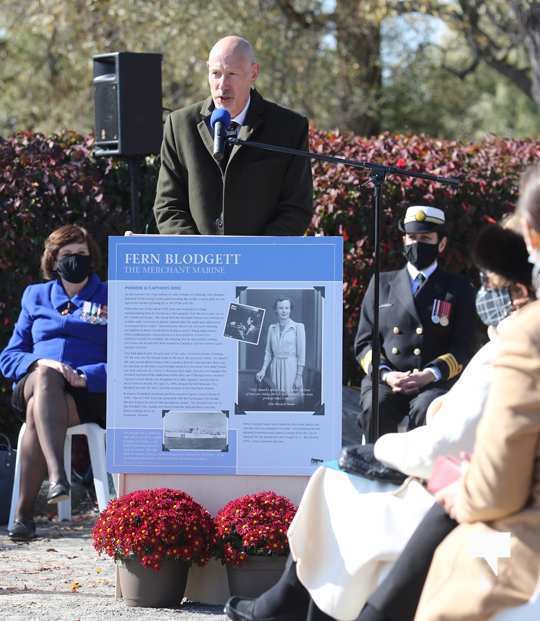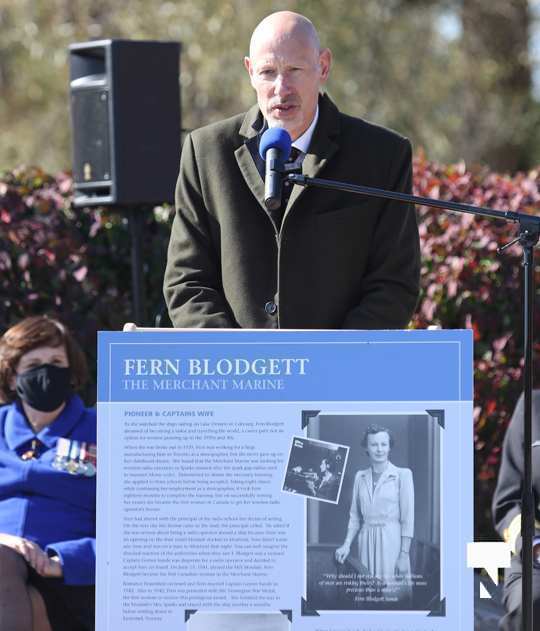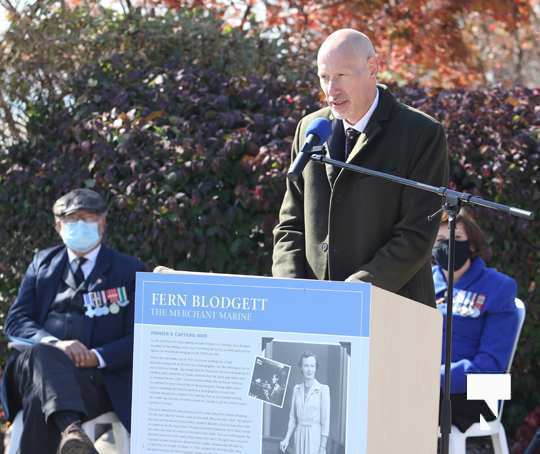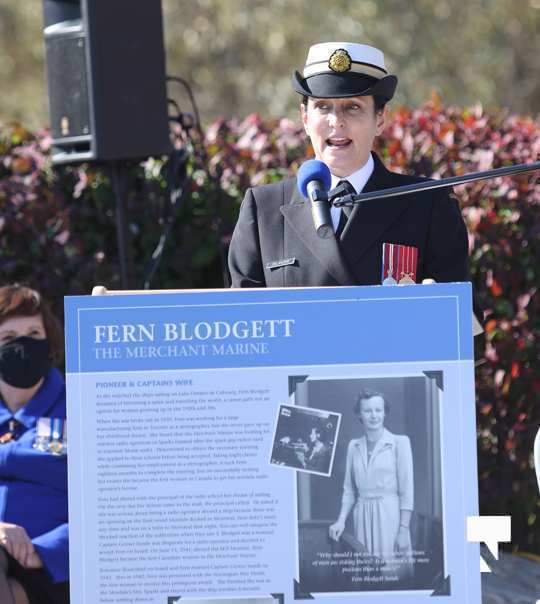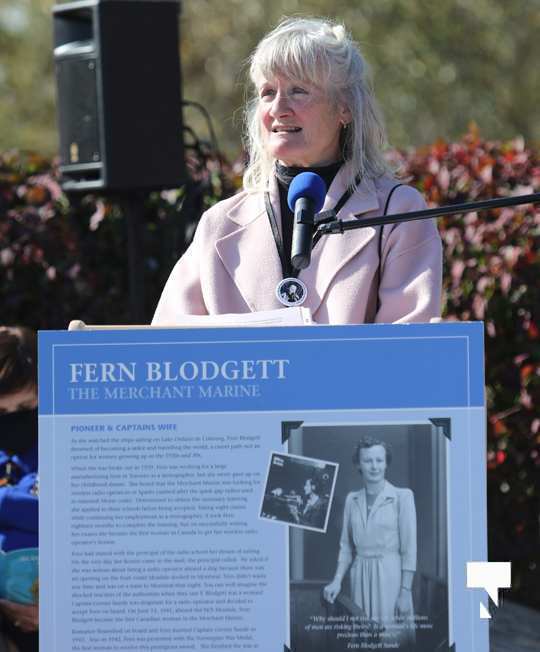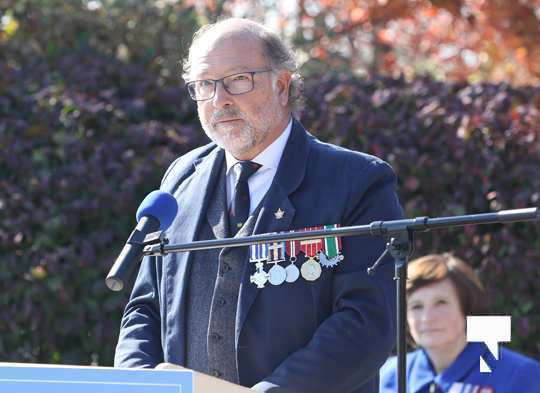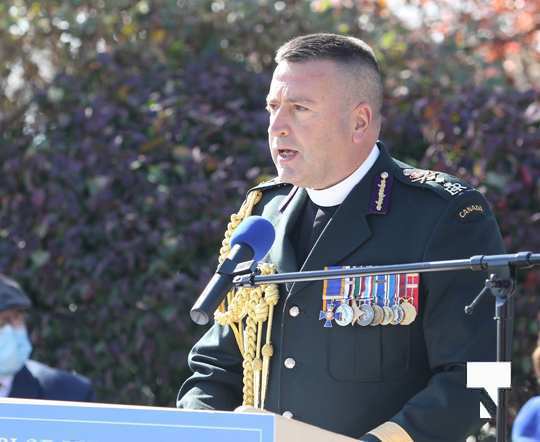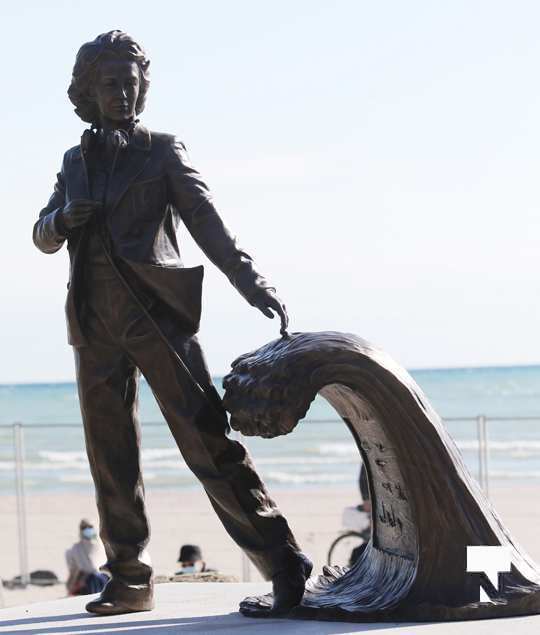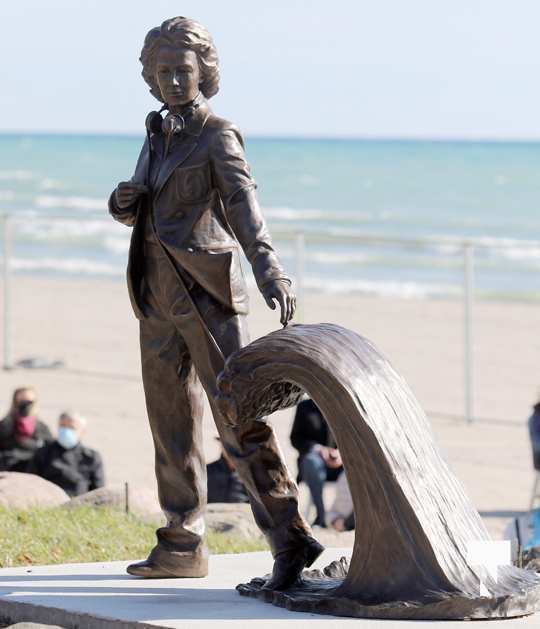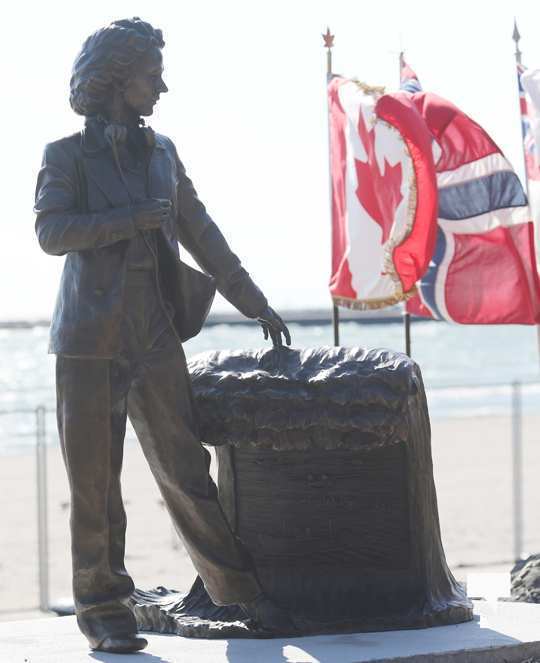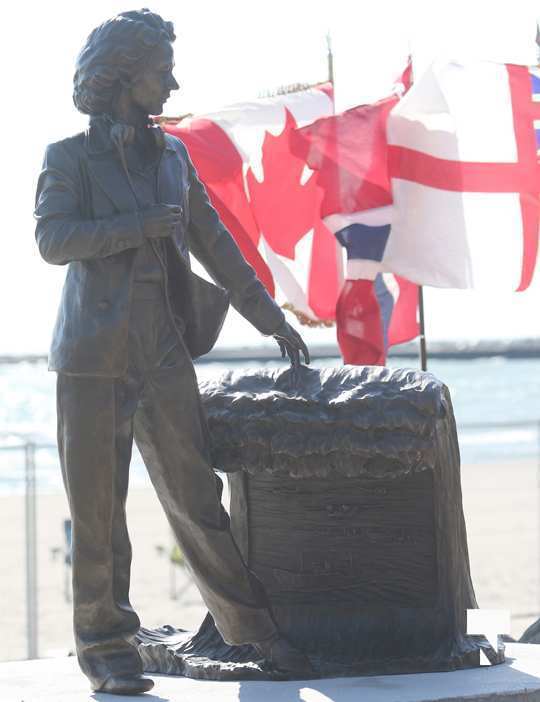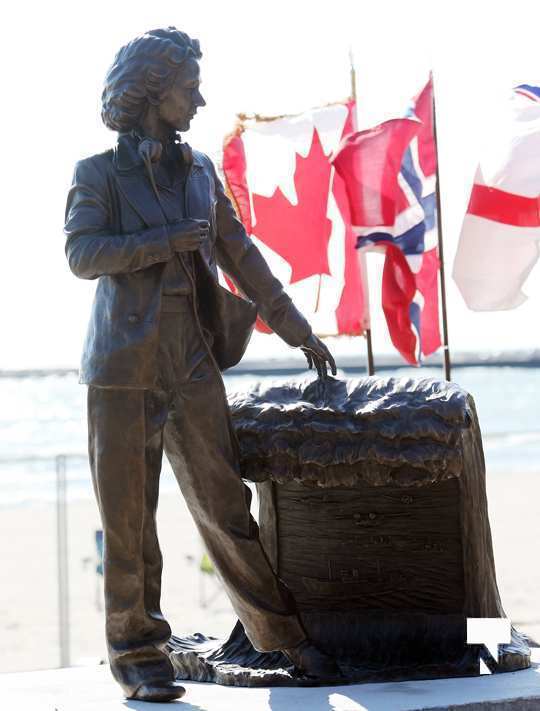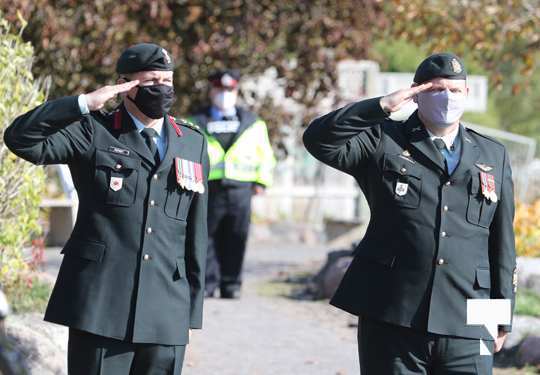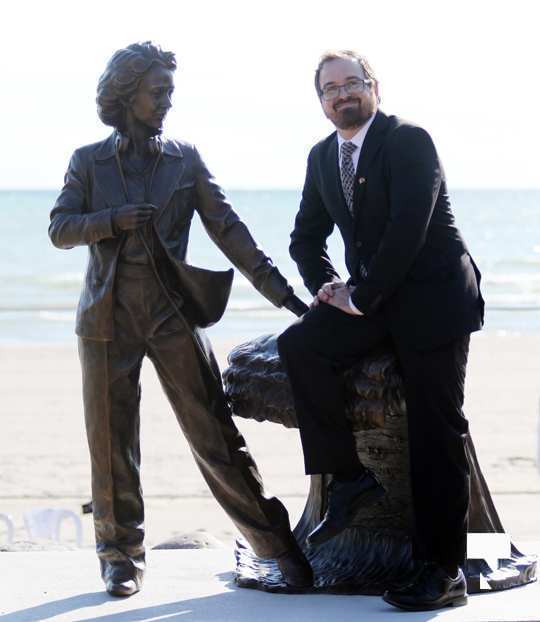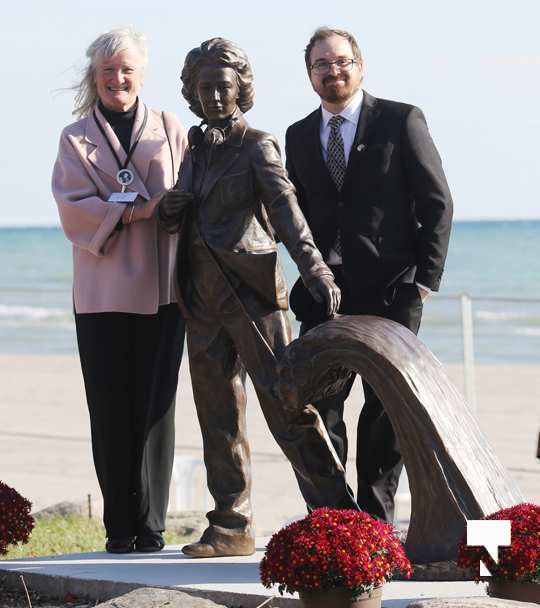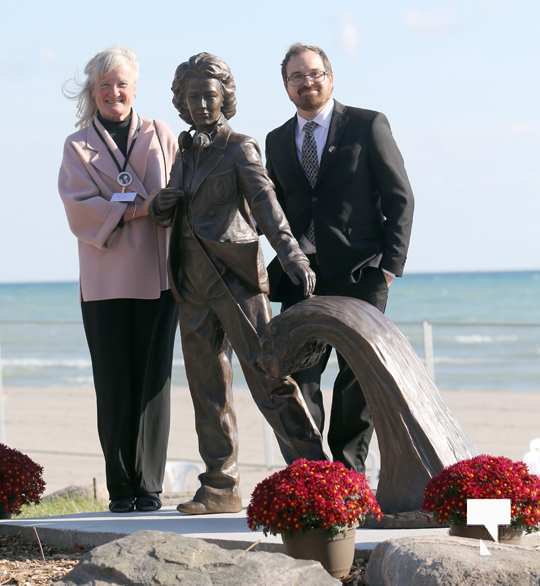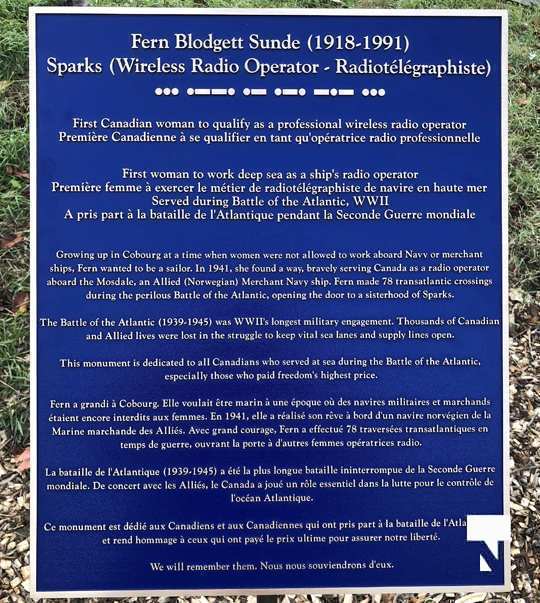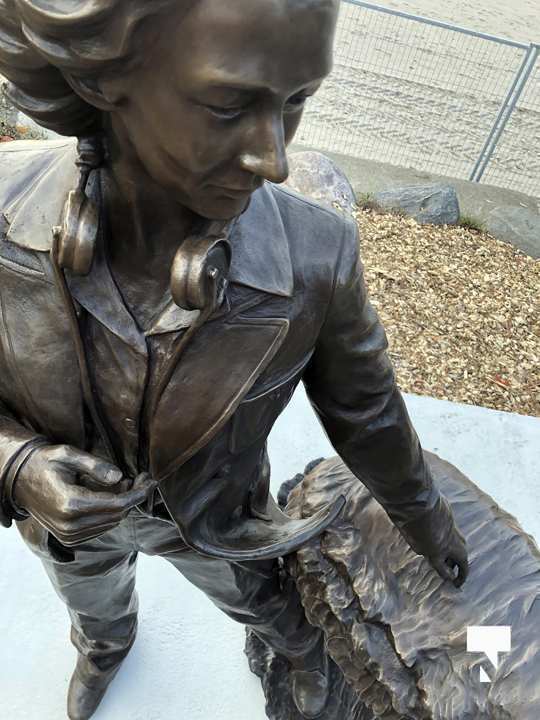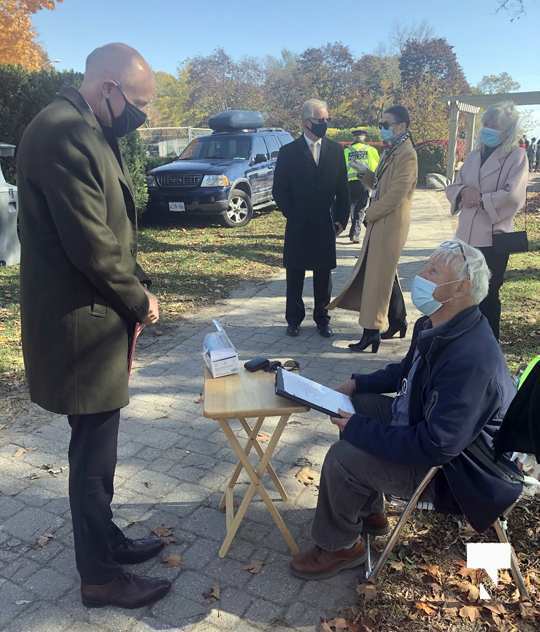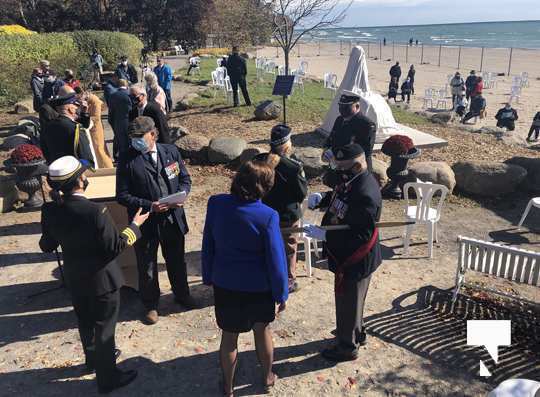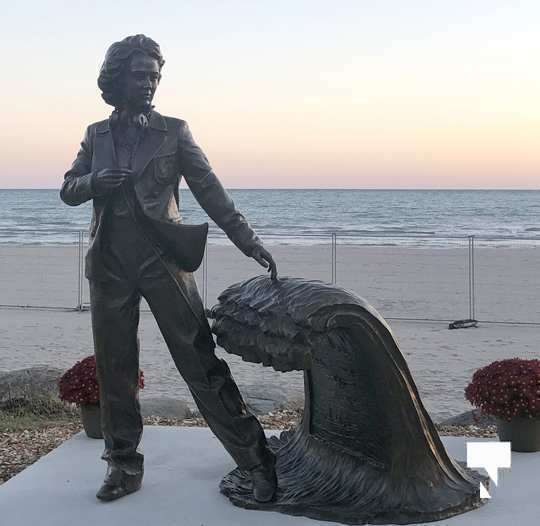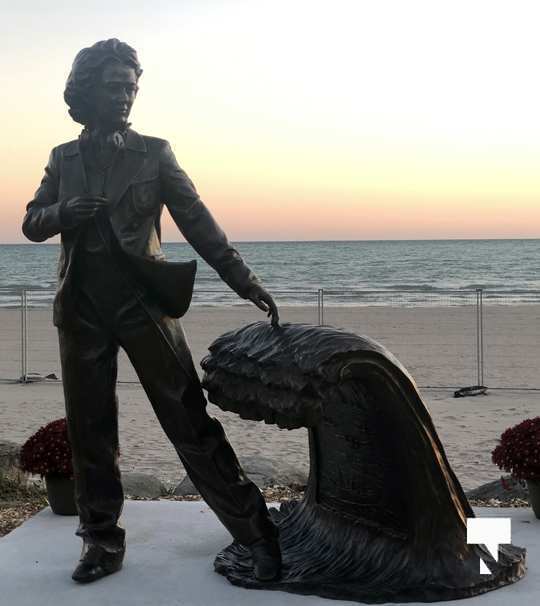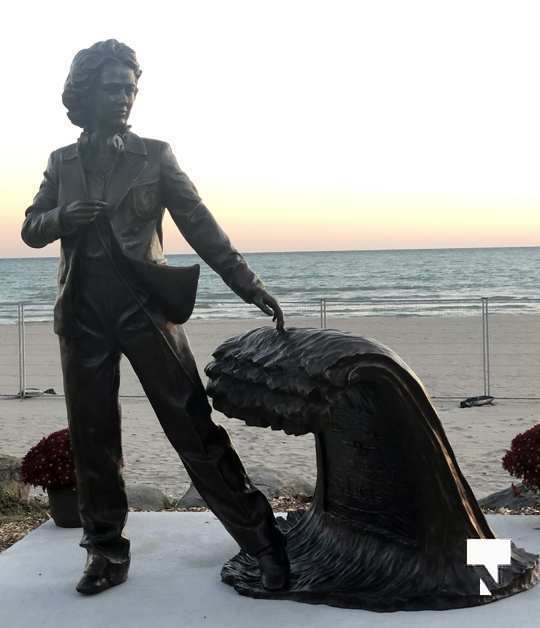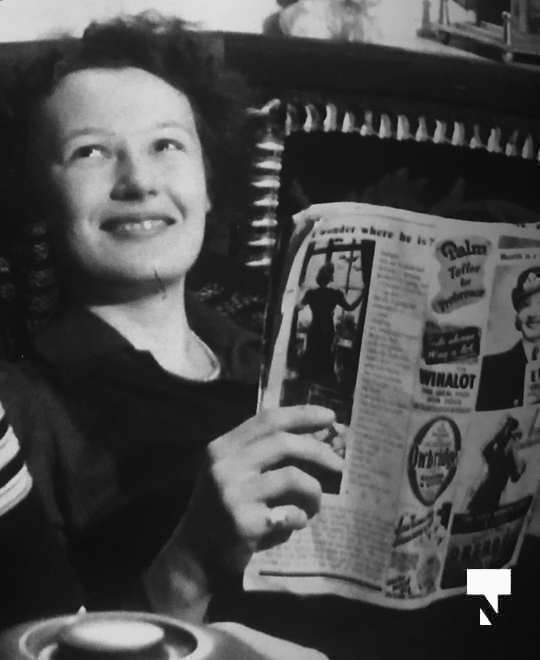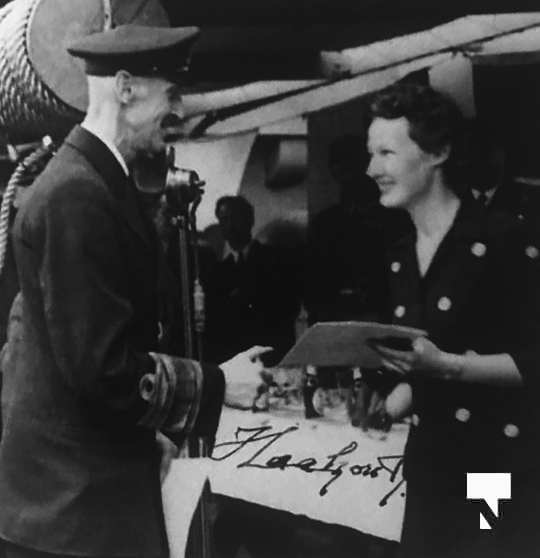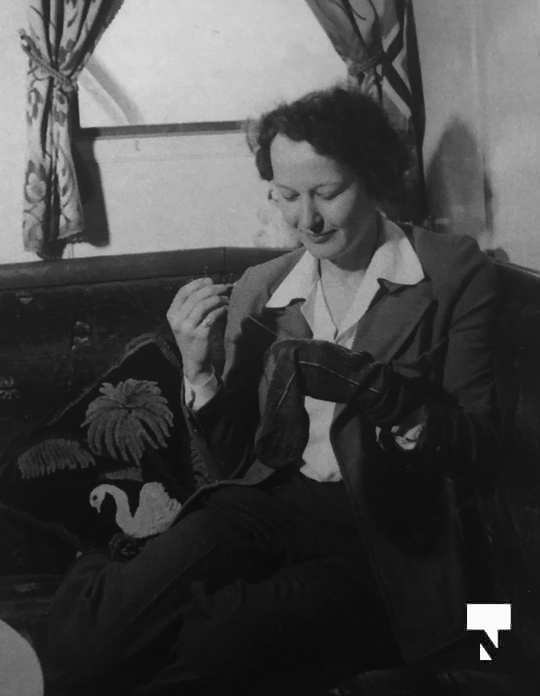A remarkable ceremony was held in Cobourg on Saturday, October 17, 2020.
It was for the unveiling of the commemorate statue of Fern Blodgett Sunde. A trailblazer who made waves for women
The event was years in the making by the Fern Blodgett Sunde Commemorative Statue Committee leading the charge.
It was through the vision of Chair of the Committee Leona Woods where the process was started and fittingly came to an end of Saturday with the unveiling of the bronze statue by sculptor Tyler Fauvelle.
Guests and dignitaries were spaced apart due to COVID-19, but the inspiration of the Blodgett Sunde could be felt on Saturday as waves crashed along the beach where she once stood looking out into Lake Ontario dreaming of her future on the seas.
Dignitaries including the Ambassador of Norway were on hand to give praise to Blodgett Sunde who was described as a trailblazer for women in the military.
Video interviews
Ambassador of Norway to Canada Jon Elvedal Fredriksen
Rear-Admiral Jennifer Bennett (Ret’d)
Sculptor Tyler Fauvelle
The story of Fern
Fern Blodgett Sunde 1918-1991
In 1941, during the Battle of the Atlantic, the Admiralty sent a secret letter to The Norwegian Shipping Mission, expressing appreciation of the outstanding services rendered to the Allied cause by three Norwegian cargo ships. The letter praised the ships’ radio operators for the “exemplary manner” in which they followed route instructions and diversions designed to keep the merchant ships out of danger.
The Mosdale, one of the ships being praised, did fact have a remarkable radio operator. Her name was Fern Blodgett, a young Canadian who was the first women ever to serve deep sea as a wireless radio operator – a “Sparks.”
Fern grew up in Cobourg dreaming of sailing the high seas, even though she knew that ships were not for girls. When WWII broke out, she was determined to serve Canada. Although some radio schools were reluctant to train women, she persisted, and became the first Canadian women to earn a Second Class Wireless Operator’s certificate.
Answering a urgent call for an operator, she made her way to Montreal. Gerner Sunde, the young Norwegian captain of the Mosdale – and Fern’s future husband – was shocked to see that his applicant was a woman. Neither Canada no Britain permitted women to work aboard ships at sea. Luckily, Norway had no rule against it. The next thing Fern knew, she was a krigsseiler – a war sailor, the only woman aboard ship, the only operator in a small radio room, where equipment instructions were in languages she didn’t know, where a mistake on her part could send the ship into catastrophe, and were she was horribly seasick.
No one expected her to make the return voyage. With great courage, resilience and devotion to duty, Fern kept a bucket by her side, and sailed with the Mosdale for 78 of its record 96 transatlantic voyages. It was incredibly dangerous – the sea as battlefield held U-boats, mind waters, surface raiders, fog and terrifying storms. During the early years of the Battle of the Atlantic, ships were going down faster than they could be replaced. Winning the war depended on victory at sea. Along with thousands of Canadians and Allies, Fern did her part during the Battle to keep Allied forces provisioned. In 1943, King Haakon VII of Norway awarded Fern Blodgett Sunde the Norwegian War Medal – the first woman ever to receive the honour.
Fern served until the end of the war, and from time-to-time in its aftermath. In 1952, she left the sea to raise her two daughters, Fern and Solveig Ann, and to work in the garden she loved. Fern stayed in Norway after Gerner’s death in 1962. She never remarried.
Fern Blodgett Sunde opened the door to a sisterhood of Sparks, mostly Canadian and Scandinavian women. They followed her to sea, working on Norwegian merchant ships until technology replaced the wireless radio.
Of the ships mentioned in the Admiralty’s 1941 letter of praise, only the Mosdale survived the war.
Cobourg Mayor John Henderson
I would like to welcome our special dignitaries – the Honourary Colonel Helen Vari; Jon Elvedal Fredriksen, Ambassador of Norway to Canada; Commander Stephanie Belanger; Rear Admiral Jennifer Bennett; Dr. Robert Gimblett; Major General Guy Chapdelaine and those representing all of our Armed Forces here today. I would like to welcome all of our guests today, here and on line, to the Meditation Garden to celebrate the life and accomplishments of Fern Blodgett Sunde, and honour the service of the veterans in the Battle of the Atlantic.
Cobourg’s history pages are filled with courageous, determined and accomplished people – people who have made history and in doing so have enriched our lives and blazed the trail for others.
We look out on the same lake here as Fern did many years ago as a child. When Fern Blodgett looked at the lake, she dreamt of working on the sea – and she pursued that dream relentlessly.
Fern’s nature was such that she did not take no for an answer. She didn’t hear the word no when she was turned down by two training schools in Toronto because she was a woman. But the third time, as it is said, “was a charm” and she was the first woman to graduate on June 13, 1941 with a professional wireless radio operator’s certificate.
Fern became the first Canadian female wireless radio operator, the first female to serve deep sea on the Norwegian merchant navy vessel the M/S Mosdale, a veteran of WWII, a hero, and a Canadian who made a difference.
Our unveiling event today is the culmination of partnership, hard work and generosity. This day would not be possible without the Committee who took an idea of great merit and saw it through to fruition.
I would like to thank the Committee, including Lt. Chris Barker, Petra Becker, Peter Delanty, Stanley Isherwood, Laura McCracken Ebbrell, Lynn Hardy, Art Seymour, Catriona Wood, and Leona Woods in partnership with the Cobourg Museum Foundation.
Rear-Admiral Jennifer Bennett (Ret’d)
It is an honour and a privilege to be here to honour a trailblazer. A true Canadian heroine and kindred spirit. Thank you for the opportunity to join you today as you unveil the statue of an incredible Canadian woman who opened doors and created opportunities for generations of women in Canada, in Norway, in Britain and around the world.
The fact that the branding for this event and the woman we are recognizing used the phrase, “make waves” immediately connected me to Fern Blodgett Sunde as I am also someone who “made waves” through being a first in my naval career that I began as a radio/teletype operator.
Throughout our nations history, Canadian women have taken a lead in shaping women’s issues and rights at home and around the world. Canadians can be very proud of the pioneering spirit of Canadian women who have played an essential role in all of the armed conflicts in which Canada has taken place, as far back as the Northwest Rebellion, serving initially in support roles, but now, proudly serving in our Canadian Armed Forces in all occupations across the ranks of officers, non-commissioned officers and non-commissioned members.
While thousands of Canadian women provided valuable wartime aid to Canada and stepped up when their nation called “to free a man for service in the armed forces,” their contributions to the war effort at home and abroad benefited not only our nation, but our society giving women a sense of purpose, pride, and confidence they would carry with them for the rest of their lives. The fact that women now serve in all aspects of naval operations and sea going occupations in the Royal Canadian Navy, Canadian Coast Guard and commercial shipping is due in large part to the hard work and adventurous spirit of women like Fern and her incredible confidence to “make waves “ to seek out opportunities, seeing that possibilities rather than obstacles and proving that, when given the chance, she would excel and open the door for others to follow.
The Second World War was a definite turning point for consideration of women in male dominated professions as the enrolment of more and more men in the army made the increased use of women across the workforce a necessity.
In late 1930’s few could have conceived of women contributing to the war effort outside of the home and Fern’s own experience of starting in traditional women’s occupations of nursing and stenography were typical and some were content to continue with these traditional roles. However, the war effort kindled in her, and thousands of other Canadian women, a new sense of not only duty but inspiration to broaden their options and opportunities. The limits and obstacles of the past, were suddenly waning and what may have been impossible in the past, wan now available with some ingenuity to create opportunities.
As history illustrates, Canada’s wartime women were far more than an emergency manpower replacement force and their service is linked to the success of our nation and the war effort of all of the Allies. Their determination and achievements opened the doors for the future of women in military and civilian careers and we owe them a debt of gratitude for not only their outstanding service and answering the call when they were needed but for changing the course of the future of Canadian women. The spirit and determination of Fern Blodgett Sunde and other trailblazers who followed live on in today’s servicewomen and we can only imagine the challenges of being not only the first, but the “only one” when Fern joined the ship. The radio room on most ships was small, cramped compartment and living conditions were not configured to allow for any privacy or comfort. There would be no rest for the Sparks at sea, especially during the dangerous Atlantic crossings. While navigators got great credit for their safe passages, the lifeline for the ship was through the radio.
The sea lanes of the North Atlantic formed a grim battleground. Navigation was hazardous and sailors in the Navy and Merchant Marine died not only from enemy attack, but from exposure and accidents in the fog and winter gales. Protection was not sufficient to prevent heavy losses. There were too few naval vessels and maritime patrol aircraft available, as well as a severe lack of training and modern equipment and technology. In the month that Fern joined the Mosdale, in June 1941 – over 500,000 tons of allied shipping were lost to U-boats. By March 1945, 463 U-boats were on patrol, compared to 27 in 1939.
Merchant vessels bore much of the brunt of the Atlantic war. With each voyage the odds of survival seemed to grow longer. Still, voyage after voyage, they sailed and sailed again.
The most important achievement of the Atlantic war were the 25,343 merchant ship voyages made from North American to British ports under the escort of Canadian Forces. These vessels delivered 164,783,921 tonnes of cargo to sustain the United Kingdom and make possible the liberation of Europe.
The Merchant Navy Book of Remembrance lists the names of approximately 1,600 Canadians who died at sea during the war, including those of eight women. Many other Canadians, whose names are unknown, were lost serving on ships of Allied Merchant Marines.
The sacrifice of the brave men and women of the Royal Canadian Navy (RCN), Royal Canadian Air Force (RCAF and Canadian Merchant Navy whose lives were lost in the Battle of the Atlantic will always be remembered .
During the battle, the longest military engagement of the Second World War, the RCN
destroyed or shared in the destruction of 33 U-boats and 42 enemy surface craft, in turn, it suffered over 2,000 fatalities and lost 33 vessels. The Merchant Navy lost 73 ships and suffered over 1,600 fatalities, and the RCAF lost more than 752 aircrew.
Each year on the first Sunday in May, Canada and its naval community commemorate those lost at sea during the Second World War.
For those who die in service at sea, there are few white crosses and cemeteries to visit as our wartime dead were lost or buried at sea and in the battles there was no time, nor safe passage to search for and recover lost shipmates. The ships had to sail on – through debris fields and do their best to rescue survivors and mark the place of the sinking on a chart for future reference while continuing to battle the enemy and ensure safe passage for their precocious cargo.
It is indeed fitting that there will be another statue and site in view of the water that flows to the Atlantic Ocean to honour Canadians who served in The Battle of the Atlantic.
In 1945, when the Second World War ended, about 750,000 women were employed in the Canadian war industry and 760,000 more worked on Canadian farms. Less carefully enumerated, but even more essential to Canada’s economic survival, were the 400,000 women who worked in regular civilian jobs.
Although the vast majority of female war-workers lost their jobs when peace came, on of the lasting effects of their employment was the gradual integration of women in professions and trades that used to be almost exclusively male. In effect, the Second World War obliterated an inescapable fact of pre-1939 Canadian society – the popular belief that women were and she remain second-class citizens.
But it would still be decades before women would be recognized as more than temporary in many occupations, including the military.
I joined the Navy in 1975 as a Ordinary Wren in the communications branch and like Fern Blodgett Sunde, I was trained as a radio operator as well as signals and teletype and women were still restricted from operational and sea-going service. When I joined the Navy, I was assigned what was considered an operational trade, but I could only sail in ships during daylight hours as women weren’t allowed to be at sea overnight and my employment was restricted to shore based message centres, much like the women of the wartime services. Women were only employed in support occupations and were not to be including on operations of any kind, although we could observe and participate to a limited extent in exercises but locations were restricted to bases or dockyards. There were limited opportunities for women to experience some time at sea and to take training related to some “naval skills” however, we could not live on board and could only sail during daylight hours and had to return to port to stay ashore overnight.
When I transferred to the Officer Corps there was no choice of occupation for female officers. I was assigned one of the two support trades in the Navy – personnel administration or logistics were the only options and men who failed Maritime Surface Training were reclassified to a support trade “with the girls.”
I was trained in sea logistics but there were still no billets for us at sea.
It was only at the end of the 1980’s that women were able to being to integrate into trades and positions that were directly linked to combat and service at sea and there were major complications, studies and trails to adapt to having women living on board the ships and integrated into existing crews. All of this would have seemed strange to Fern who arrived and reported to her ship and sailed shortly after her brief orientation.
The Navy I joined was very different from that of today and I have had the incredible opportunity to have seen and been able to influence and effect some incredible change for women in leadership roles in the Canadian Armed Forces by “making waves” but I certainly didn’t set out to be a trailblazer and I join a long and proud line of women who have served Canada.
Women who entered new fields became leaders and role models as well as being known as “firsts” and many times were also “the only one.”
This was not easy and the pressure was on to not only do a good job, but to prove that women could do the work, and do it well. Success for the first women meant that from the very beginning, we had to work hard, be exceptional leaders and have great personal drive. There were often no other women to show use the way and the pressure was on to “break new ground.”
Being in the spotlight quickly list its appeal as women didn’t want to be centred out. We just wanted to be treated as equals. However, being a trendsetter or pioneer was and continues to be an important role and being a first comes with a unique set of challenges but also opportunities to influence change, create opportunities and open doors.
While I experienced many “firsts” for women in my military career, whenever that was highlighted there tended to be increased interest and attention and while I tried to downplay these firsts, these were important milestones and barriers toppled and is of interest to women within and outside of the military.
After the firsts have been announced, the stories generally don’t concentrate solely on the aspect of being “a first” any more and are very positive in delivering a message that encourages other women to strive for goals they once thought were out of reach or unattainable. It is incredibly important for others to be able to see themselves through the success of others. Fern became an example for others to follow and started her own “revolution” that became an “evolution” and “sisterhood of Sparks at Sea” when 21 other Canadian women follower in her footsteps serving as operators on Norwegian Merchant ships during the warm and many other women pursued the same career path after the war.
Despite the growing number of women in all career paths, there are still some anomalies about being of a very small group or a “first” but there are also advantages. When I attended meeting with my military peers in the Canadian Armed Forces or NATO, there was never a line up for the women’s washroom at break time….this is probably the only place in our society where that happens.
Today, Canadian women are fortunate to be following in the footsteps of other successful women who have led the way and have less pressure to demonstrate that women can do the job and wile we continue to have “firsts” they aren’t subject to the same level of scrutiny but it has taken us a long time to arrive at this point.
However, in my military career, my leadership role and being a woman who has been a trailblazer, has had a far greater reach than expected. Over the years I have had many people approach me and tell me that I have been an example or a role model for them and they had learned a great deal from my career and my actions, while I had never actually met them or worked with them. It is quite humbling and also quite intimidating to know that through what I was doing and who I was, others were finding their way and wanted to follow in my footsteps. People were inspired by what I had accomplished and achieved as well. As who I was, as well as being true to my own unique style of leadership and management was an example to others.
Never underestimate the power of what you do and who you are. Your legacy goes beyond a job title, ran and official responsibilities; it is how you do things. It is not what you are known as, but what you are known for. What started as a temporary summer job with no aspirations or goals, led me towards incredible leadership opportunities that have taken me across Canada and around the world. I’ve had experiences that have challenged me and pushed me beyond my limits and I was given responsibilities and assignments that I never thought were possible or achievable and many were things that had not been done before.
I didn’t set out to rise to a certain rank or position and there weren’t very many women in the higher ranks so I didn’t see this as a long term goal, I was just looking for something interesting to do – and I certainly found that and more! It wasn’t always easy, but it has always been interesting and very rewarding and because I didn’t have a “route” mapped out I also became a trailblazer and like Fern, had to be persistent, brave, creative and resilient and learn that “if opportunities don’t present themselves, go out and find them or make your own happen. You are in charges of your own future.”
True leadership is about seeing possibilities rather than problems. Sometimes you have to take chances and make an opportunity fit for you, rather than the other way around.
Today’s female service members are carrying the torch of trailblazers like Fern, and thanks to them, today’s generation of Canadian women are joining the Royal Canadian Navy with all doors open to them and a wide ranger of career opportunities as equal partners. Much like Fern, today’s young women have a “can do” attitude and they are meeting challenges head on and are excelling in leadership positions from Ordinary Seaman to Admiral.
As Fern lived out her dream of working at sea and as I look back on my career, I think we both share a common philosophy that your success isn’t only contingent on what you achieve and it’s not what you are known as; but what you are known for.
I consider my greatest accomplishment and legacy to have been to show others what is possible, to have opened the doors to those who will follow, and to have contributed to and influenced the success of others, all while being true to myself, remaining open to being outside my comfort zone, and most importantly maintaining my personal leadership style and making waves.
In the language of signal flags and radio transmissions I offer a “Bravo Zulu” to the Cobourg Museum Foundation, the committee of volunteers and all those responsible for this wonderful and lasting tribute to a true Canadian heroine and the honour to all Canadians who served during The Battle of the Atlantic.
“B-…Z–..
Sculptor Tyler Fauvelle speech discussed the sculpture and what it means.
I am always amazed at the power of community – in this case, how people gathered together to create a lasting tribute to Canadians of a monumental generation, the men and women who fought and supported a necessary war. Thousands didn’t live to see the peace their sacrifice bought, and they were on my mind when I created the sculpture.
Today, we see Fern stepping forward with one foot emerging from an impressionistic wave, but she is also looking back, with her hand just grazing the tope of the wave. Forward is her persistence in breaking barriers – looking back is in remembrance.
Fern’s clothing is typical of what she wore as she carried out her duties as a wireless radio operator aboard the Mosdale. The headphones slung around her neck symbolize her profession; the pin on her lapel commemorates the sisterhood of Sparks who followed her to sea. The wave she touches symbolises the wave of social changes which came from Canadian women in the storm of war. The wave also represents radio waves, and the waves of the sea as battlefield.
I’d like to draw your attention to the reliefs sculpted inside the wave. I designed it to seem as if the viewer is looking through a window, out to sea. The planes and ships are lined to Canada’s central role in the Battle of the Atlantic.
The passenger ship represents the SS Athenia. On September 3, 1939, a German U-boat torpedoed the ship, killing 112 civilians. Hannah Baird, a stewardess on the Athenia is considered the Canadian Merchant Navy’s first fatality of the Second World War.
You will also see a rendering of a true amphibious aircraft, which is the Royal Canadian Air Fore called the “Canso.” Canadian built 730 Cansos, which served with the eleven RCAF Squadron, operating on both coasts.
The reliefs included the storied Hawker Hurricane. Although known for its role in the Battle of Britain, the plane fought in all the major theatres of World War II, including the Battle of the Atlantic. A significant manufacturer was Canadian Car and Foundry, located in what is now Thunder Bay, Ontario. The Chief Engineer, the renowned Elsie MacGill became known as the Queen of the Hurricanes.
Escorts groups were made up of several small warships, trained in anti-submarine tactics. Their job was to defend shipping convoys. One of those warships was The HMCS Waskesiu, represented here. A river-class frigate built in Canada, it was first of its class commissioned into the Royal Canadian Navy, and the first Canadian frigate to sink a U-boat.
Canada built over one hundred corvettes. Small and quickly built, the Flower-class corvette became an essential resource for convoy protection, until enough larger vessels could be built. The Flower-class corvette shown here represented the HMCS Cobourg, which was named after the Town of Cobourg.
As I was sculpting the reliefs, I made the skies heavy and dark, and very lightly outlined U-boats on the horizon. I thought it was important to symbolize the sinister danger that claimed thousands upon thousands of Allied lives.
For her family watching this in Norway, I want you to know that while I’m aware that Fern’s story is one of courage, persistence, and sacrifice, I also know that it’s a love story. I lightly traced a wedding ring on her finger, in remembrance of the young Norwegian Captain who had no idea he was hiring his future wife. Together, they faced danger and hardship at sea, and did everything they could to support the Allies in the fight against the Nazis. Fern was only in her forties when Gerner died suddenly.
She also told her daughters that there was only one true love for her, and she never remarried. Thank you for sharing your parents’ story, and your family photos.
I hope this monument will inspire people of all ages, especially youth, to pursue their dreams and to honour the generation who gave so much in the cause of freedom.
Please persist. Be brave. Make waves.
Thank you all so much. Merci, tusen takk.


